

"In 2010, we adjusted our strategy in South Africa, from selling low-end products to high-end ones. Right now, our pricing in Africa is almost equal to international brands such as LG and Samsung," said Zhu Dan, president of Hisense Middle East-Africa Holdings Co Ltd.
"The market is growing at an average pace of 20 percent year-on-year. Our refrigerators, televisions as well as air conditioners are very popular in the marketplace," Zhu said.
Zhu added that they simply expected to sell as many products as possible in past years. However, as the market has changed, the company decided to position itself as an international brand. It made changes in its management, product mixture and selling channels.
According to data from Germany-based research firm GfK Group, in South Africa, the market share for Hisense refrigerators grew from 8 percent to 12 percent from January 2012 to June 2012, ranking it third behind two local brands, KIC and DEFY Appliances.
Hisense high-end series of refrigeration products have been available at Dion, South Africa's high-end home appliance channel, and Hirsh, a high-end single shop, since 2011. In 2012, Hisense refrigeration products have been brought into two more channels, Mass Mart and Pick n Pay, which belong to Wal-Mart Stores Inc.
The company said that it plans to double the size of the factory over the next few years and increase its staff to 1,000, with a view to extending the production of washing machines, air-conditioning units and, possibly, wine coolers and coffee machines.
"We are confronted with the problem of how to better localize. We hope to have more local senior talent, not just workers. Currently, about 50 percent of our workers are Chinese," Zhu said.
However, not every Chinese maker is as lucky as Hisense in establishing an authentic brand in the process of expanding in the market.
As a latecomer to South Africa, Qingdao Hichanse Group Co Ltd is still selling original equipment manufactured products there.
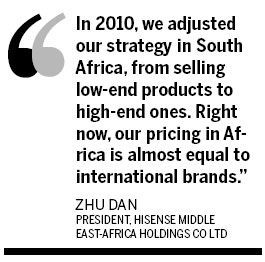
"We began to work with our agent in South Africa in 2009. After two years' flat growth, our business started to boom in 2012, when our sales volume increased 50 percent compared with 2011. Meanwhile, we launched our own branded kitchen ventilator after our agent asked for it," said Jiang Hongxia, a sales manager with Qingdao Hichanse Group.
In general, the company exported fewer than 2,000 kitchen ventilators in 2012, each costing $300 to $400. Still, original equipment manufactured products account for 90 percent of the company's total business in the market.
"We have got certification in the market but we lack information about buyers or dealers. It is much more difficult to operate our own brand in the marketplace," Jiang said.
Competitive edge
Compared with local products, Jiang said Chinese makers are gaining competitive edge in terms of quality and design, especially in the upper-end market.
"But we are also losing customers because we are not as competitive as local producers because we have problems with after-sales services as well as finding distribution channels," said Jiang.
Because it is much easier for buyers to accept products with new technology and design, Jiang said her company will focus on the middle- and high-end market, while continuing to update products.
In addition to expanding sales abroad, experts said it is also important for Chinese exporters to develop brands because branded names are gaining popularity in the market.
"I am very confident about the future of South Africa's small appliances, food and personal-care markets because the cooperation between China and South Africa is diversifying," said Roger Carbonell, commercial director of consumer choices with Sub-Saharan Africa at GfK Retail & Technology Group.
Carbonell said price increases in high-value segments combined with price erosion in mass categories were because at first glance the market was sluggish.
When it comes to how to solve Chinese exporters' sales channel problems, Carbonell said modern and formalized retail structures are dominating the market.
Therefore, breaking into the established mature system is something of a challenge for Chinese sellers.
"As for small appliances, the mid-tier market is declining. You either build strong brands or you become highly price-aggressive," said Carbonell.
 Jimmy Lin Zhiying, models at Toyota pavilion
Jimmy Lin Zhiying, models at Toyota pavilion
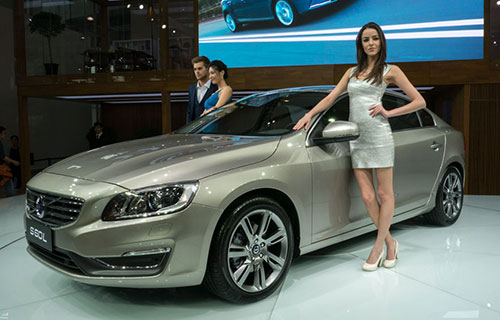 Volvo all-new S60L world premiere at Guangzhou auto show
Volvo all-new S60L world premiere at Guangzhou auto show
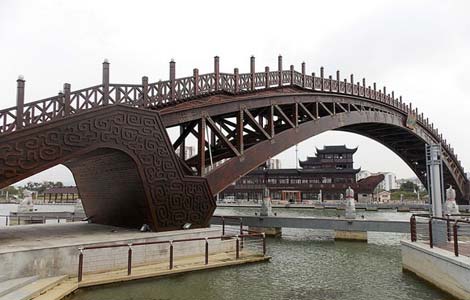 Largest span timber arch bridge
Largest span timber arch bridge
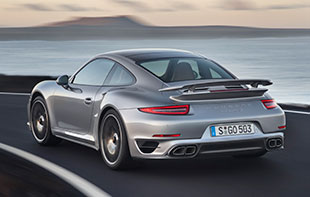 Porsche 911 Turbo S Asian premiere fascinates Auto Guangzhou
Porsche 911 Turbo S Asian premiere fascinates Auto Guangzhou
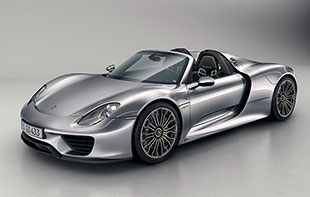 Auto Guangzhou witnesses new Porsche sports cars Asia Premiere
Auto Guangzhou witnesses new Porsche sports cars Asia Premiere
 2013 Guangzhou auto show carmakers' eventers
2013 Guangzhou auto show carmakers' eventers
 Models at Volvo pavilion at 2013 Guangzhou auto show
Models at Volvo pavilion at 2013 Guangzhou auto show
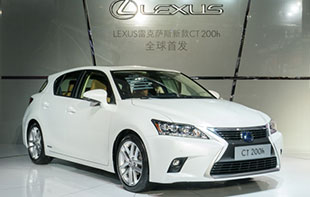 Lexus new hybrid hatch CT200h world premiere in Guangzhou
Lexus new hybrid hatch CT200h world premiere in Guangzhou